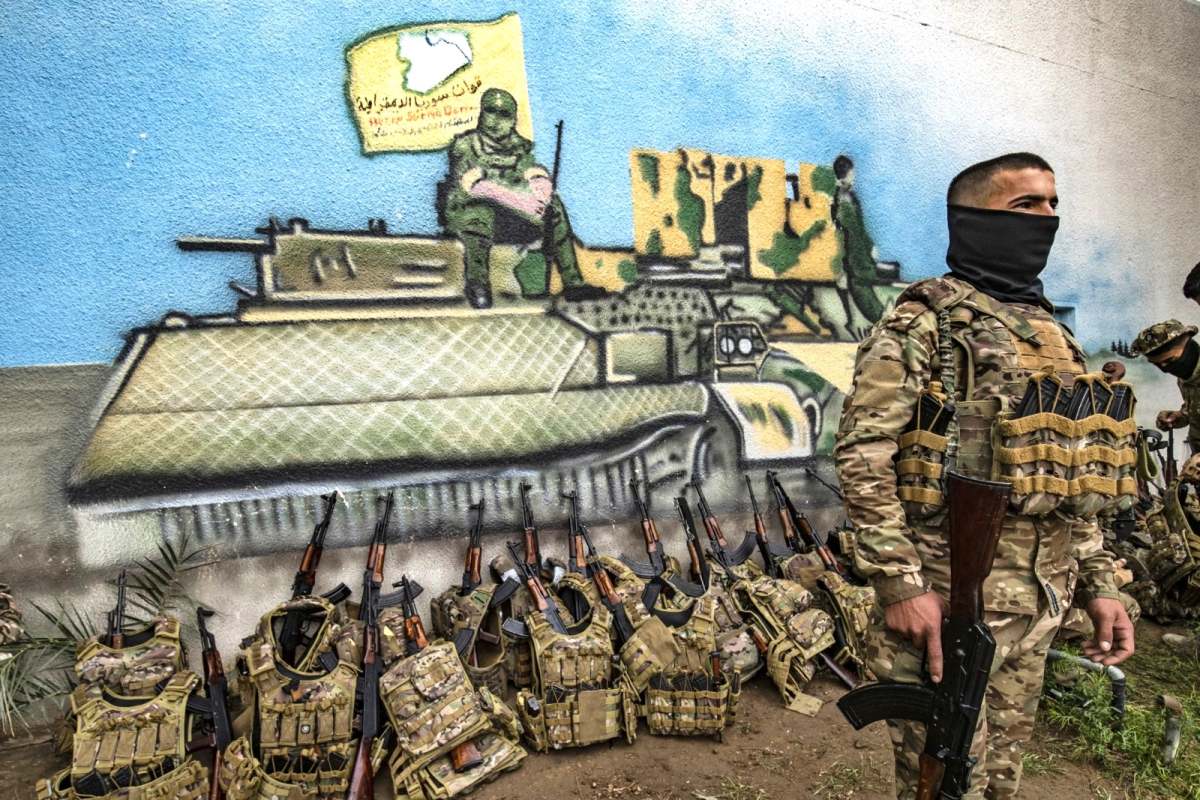Syrian Regime & Iran Attempt to Undermine SDF in Deir ez-Zor
By Wladimir van Wilgenburg
According to the latest Pentagon’s Lead Inspector General Quarterly Report to Congress for the period of April 1 through June 30, 2024, published on August 1, the Syrian Democratic Forces (SDF) “were further stretched by the tensions with Arab tribal fighters” in Deir ez-Zor.
The U.S.-led military Coalition against ISIS also stated that while there were no signs of significant intensive fighting between the SDF and Arab tribal fighters in the Middle Euphrates River Valley (MERV) in Deir ez-Zor from April to June, periodic clashes forced the SDF to retain reinforced units and fighters in defensive positions on the east bank of the Euphrates.
However, recently, Syrian-regime backed groups carried out a new widespread attack on the SDF-held east bank of Deir ez-Zor on August 6. The groups crossed the Euphrates River backed by Syrian government artillery and mortars from the west bank of the river that splits Deir ez-Zor in two. On August 7, the SDF said the attack was repelled. However, on August 9, 11 civilians were killed in continued shelling by the Syrian government. Asayish forces also blocked roads to regime-held security zones in Qamishli and Hasakah.
Moreover, the leader of the SDF-linked Deir ez-Zor Military Council, Turki Al-Dhari, also known as Abu Laith Khasham, claimed the attack was ordered by Hossam Luka, head of regime military intelligence, and led by Hashem Al-Sattam, leader of regime-affiliated militias in Deir ez-Zor. Al-Sattam was also involved in attacks on the SDF in September 2023.
The UAE-based news website The National quoted a Syrian government official, who said the attack was led by the pro-Iranian militia called Lions of Okaidat. It said that force included disgruntled fighters from other tribes who participated in a failed uprising last year against the SDF.
The website Syria Direct also confirmed the attack came from the Western bank of Deir ez-Zor, and also reported that a video was circulated showing Al-Sattam was involved in the attack.
In February 2023, the Pentagon’s Lead Inspector General Quarterly Report for the period of October 1- December 31, 2023, noted that the fighting between the SDF and Arab tribal groups first erupted in August 2023, after the SDF removed the commander of the Deir ez-Zor Military Council, Abu Khawla, accusing him of criminal activity and colluding with the Syrian regime. He was also criticized by locals for corruption.
The SDF began working with Abu Khawla in 2016 to combat ISIS in Deir ez-Zor due to the lack of alternatives.
Initially, the SDF was hesitant to enter Deir ez-Zor and Raqqa, preferring instead to link the Kurdish enclaves along the Syrian border from Derik to Afrin. However, they were compelled to enter these areas to prevent the U.S. from collaborating with Turkish-backed rebels, which could have jeopardized SDF-held territories. Therefore, it was difficult to find local allies for the SDF in Deir ez-Zor, which has no Kurdish population.
Following Abu Khawla’s arrest in 2023, there were clashes in August, September, and October. While Abu Khawla’s supporters were quickly defeated by the SDF, things became more serious, when in late August, local Akeidat tribal head Sheikh Ibrahim Hifl joined the insurgency, whose base was in the SDF-held area of Dhiban.
However, after the insurgency failed, in September he fled to the regime-controlled western bank and continued to call for attacks on the SDF in audio recordings.
As a result, the area around Dhiban remained a hot spot for the insurgency, while other parts of Deir ez-Zor remained relatively calm. According to the UK-based Syrian Observatory for Human Rights (SOHR), the attacks were centered on Dibhan, Al-Latwah and Abu Hamam.
During the last August attack, Hifl also released audio recordings calling for ‘liberating’ the area from the SDF.
According to the 2023 Pentagon report, the tribal fighters have emerged as a “full-fledged resistance movement” that is receiving explicit support from the Syrian regime and its Iranian allies on the western side of the Euphrates River, where resistance fighters resupply, rearm, and launch attacks across the river in SDF-controlled villages on the eastern side.
Nevertheless, the U.S.-led Coalition said that Arab militias are unlikely to gain control over areas held by the SDF.

When fighting erupted in August following the dismissal of Abu Khawla, some local activists and critics of the SDF in Deir ez-Zor expressed support for Arab insurgents opposing the SDF, and denied the insurgents were backed by Iran and Damascus, and were only acting due to Arab grievances over Kurdish control of Deir ez-Zor.
However, it slowly became clearer for many that the unrest was sparked by the Syrian regime. For instance, Syrian researcher Muhannad Katee told The National that unlike the ‘popular uprising’ last year, the latest attack was backed by Iran and that “the people see it as an Iranian move and it will fizzle down.”
Even pro-Syrian opposition websites like Syria TV report that Ibrahim al-Half and the insurgents are backed by Iran. Also Levant 24, reports that Iran wants to undermine stability in areas under control of the U.S.-backed forces.
Therefore, it is difficult for the insurgents to gain popular support. Although the Arab tribes in Deir ez-Zor have their reservations and criticisms of SDF rule, many of them fear the return of Syrian government control.
According to the latest Pentagon report, the U.S. State Department thinks popular support remains with the SDF rather than the Syrian regime. Moreover, they underlined the importance of reform by the SDF and local authorities to undercut the ability of Syrian-regime backed insurgents to infiltrate the community.
There is also criticism of the slow implementation of the promise of governance and service delivery reforms announced at the October 2023 conference by the Democratic Autonomous Administration of North and East Syria (DAANES) and during meetings between tribal leaders and the SDF leadership.
Therefore, the attacks by Arab militias backed by Damascus and Iran are likely to continue, but it is unlikely that these groups will be able to seize control of SDF-held areas in Deir ez-Zor due to a lack of local support, the SDF’s military capabilities, and the presence of U.S. forces.
It is also relatively easy for insurgents to cross the river from regime-controlled areas and attack the SDF, unless the SDF pushes into regime-controlled areas on the West bank. Such a move would unlikely be backed by the U.S. since it would create issues for the 2017 deconfliction line between Russia and the United States military in Deir ez-Zor dividing Deir ez-Zor between SDF-held and regime-held areas.
Additionally, Iran has an interest in creating instability in Deir ez-Zor due to the presence of U.S. bases in oil and gas fields in the area. Iran-backed groups have continued to carry out attacks on U.S. bases both in Iraq and Syria. Iran seeks to expel U.S. forces from Syria and Iraq, and tensions in the region have increased further due to the ongoing war in Gaza. North Press reported that the recent attacks were also coordinated with the Iraqi Popular Mobilization Units (PMU).




Comments are closed.